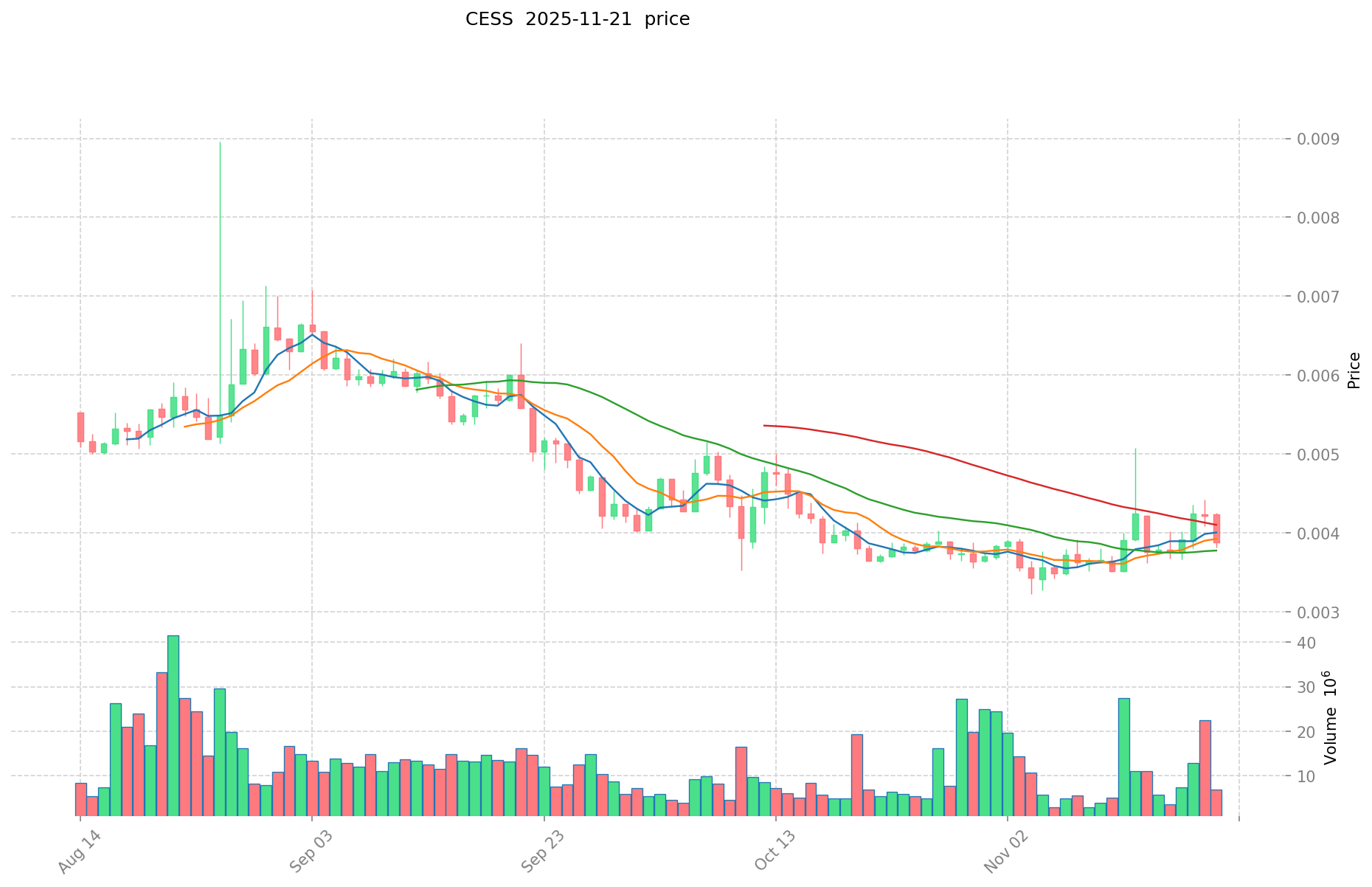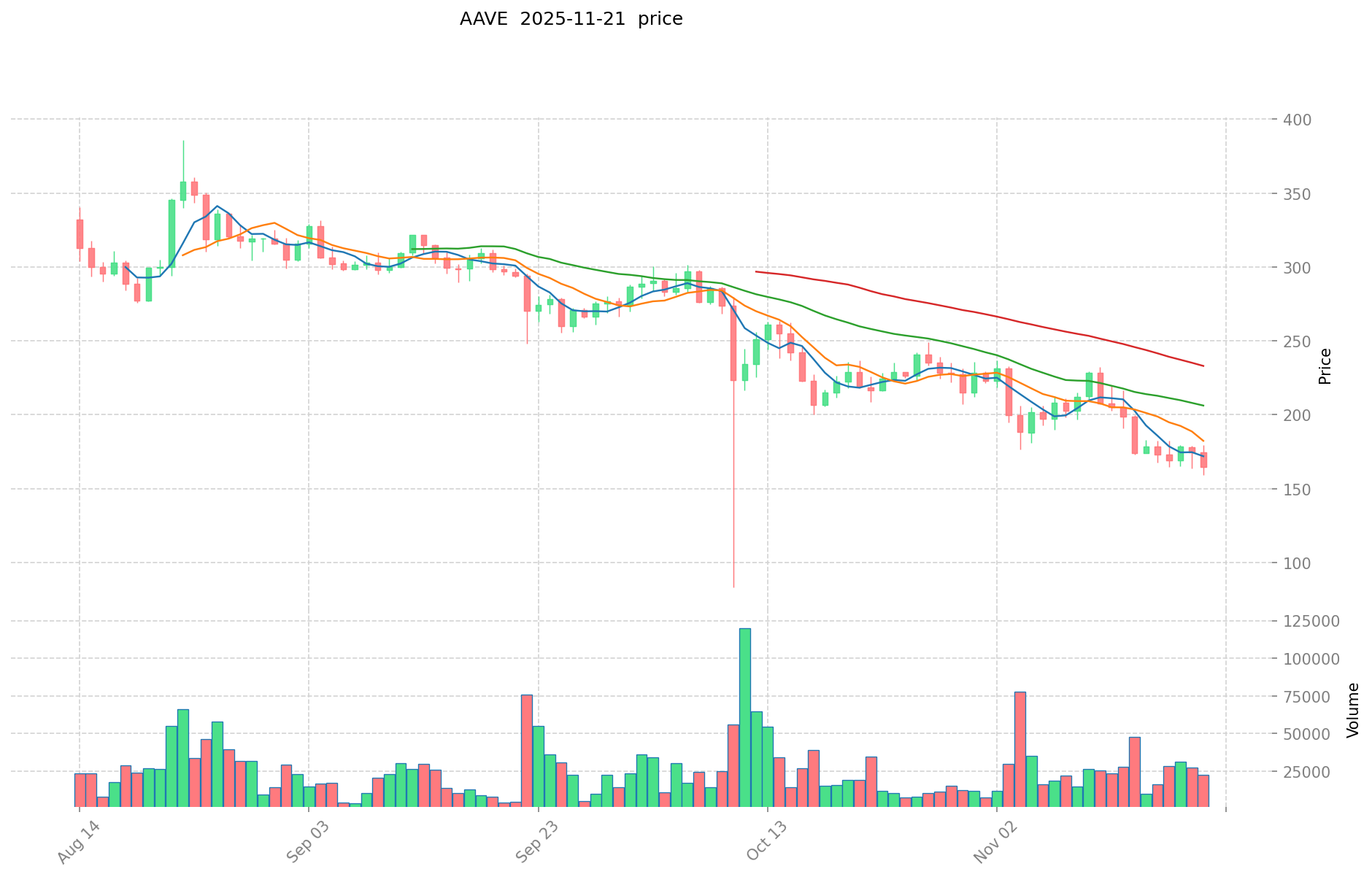CESS vs AAVE: Exploring the Differences Between Decentralized Storage Solutions and DeFi Lending Protocols
Introduction: CESS vs AAVE Investment Comparison
In the cryptocurrency market, the comparison between CESS vs AAVE has been an unavoidable topic for investors. The two not only show significant differences in market cap ranking, application scenarios, and price performance but also represent different positioning in crypto assets.
CESS (CESS): Since its launch, it has gained market recognition for its positioning as a Layer1 decentralized infrastructure for data value.
AAVE (AAVE): Since its inception in 2020, it has been hailed as an open-source decentralized lending protocol, becoming one of the cryptocurrencies with the highest global trading volume and market capitalization.
This article will comprehensively analyze the investment value comparison between CESS vs AAVE, focusing on historical price trends, supply mechanisms, institutional adoption, technological ecosystems, and future predictions, attempting to answer the question investors care about most:
"Which is the better buy right now?"
I. Price History Comparison and Current Market Status
CESS (Coin A) and AAVE (Coin B) Historical Price Trends
- 2025: CESS reached its all-time high of $0.02004 on June 26, but quickly dropped to its all-time low of $0.00207 the next day on June 27.
- 2021: AAVE hit its all-time high of $661.69 on May 19, showcasing significant growth in the DeFi sector.
- Comparative Analysis: While CESS has experienced extreme volatility in a short period in 2025, AAVE has maintained a more stable long-term price trend since its peak in 2021.
Current Market Situation (2025-11-21)
- CESS current price: $0.00335
- AAVE current price: $157.73
- 24-hour trading volume: CESS $30,268.47 vs AAVE $5,020,738.29
- Market Sentiment Index (Fear & Greed Index): 14 (Extreme Fear)
Click to view real-time prices:
- Check CESS current price Market Price
- Check AAVE current price Market Price


II. Core Factors Affecting the Investment Value of CESS vs AAVE
Supply Mechanism Comparison (Tokenomics)
- CESS: Total supply of 10 billion CESS tokens; 30% for mining rewards, 25% for ecosystem development, 17.5% for private sale
- AAVE: Fixed maximum supply of 16 million AAVE tokens; employs a deflationary model where a portion of protocol fees is used to burn AAVE tokens
- 📌 Historical pattern: AAVE's deflationary model has historically created upward price pressure during periods of high protocol usage, while CESS's tokenomics are designed to balance incentives for storage providers
Institutional Adoption and Market Applications
- Institutional holdings: AAVE has established presence in institutional portfolios with major funds and crypto investment firms participating in its ecosystem
- Enterprise adoption: AAVE has gained traction in DeFi lending markets, while CESS aims to disrupt the Web3 storage market with enterprise-grade decentralized storage solutions
- Regulatory attitudes: AAVE operates in a more mature regulatory framework as a DeFi lending protocol, while CESS faces different regulatory considerations as a decentralized storage solution
Technical Development and Ecosystem Building
- CESS technical upgrades: CESS mainnet launched in May 2023; implementing innovative multi-layered storage architecture with Random Rotational Selection (R²S) consensus and DeOSS technology
- AAVE technical development: Established V3 protocol with increased capital efficiency, cross-chain functionality, and risk management features
- Ecosystem comparison: AAVE has a mature DeFi ecosystem with over $5 billion in TVL across multiple chains; CESS is building a decentralized storage ecosystem with enterprise-grade applications for data security and verifiable storage
Macroeconomic Factors and Market Cycles
- Performance in inflationary environments: AAVE tends to perform in correlation with overall DeFi activity, while CESS could potentially benefit from increasing data storage demands regardless of market conditions
- Macroeconomic monetary policy: Both tokens are influenced by broader crypto market sentiment, which is affected by interest rates and USD strength
- Geopolitical factors: CESS's decentralized storage solution may gain additional value in regions with data sovereignty concerns or censorship issues
III. 2025-2030 Price Prediction: CESS vs AAVE
Short-term Prediction (2025)
- CESS: Conservative $0.00198535 - $0.003365 | Optimistic $0.003365 - $0.0046437
- AAVE: Conservative $85.5198 - $158.37 | Optimistic $158.37 - $169.4559
Mid-term Prediction (2027)
- CESS may enter a growth phase, with expected prices ranging from $0.0030833495 to $0.0059024119
- AAVE may enter a bullish market, with expected prices ranging from $186.0821764875 to $256.5975275775
- Key drivers: Institutional capital inflow, ETF, ecosystem development
Long-term Prediction (2030)
- CESS: Base scenario $0.004388121588225 - $0.006180452941162 | Optimistic scenario $0.006180452941162 - $0.006736693705867
- AAVE: Base scenario $162.6732737365428 - $290.487988815255 | Optimistic scenario $290.487988815255 - $403.77830445320445
Disclaimer: This information is for educational purposes only and should not be considered as financial advice. Cryptocurrency markets are highly volatile and unpredictable. Always conduct your own research before making any investment decisions.
CESS:
| 年份 | 预测最高价 | 预测平均价格 | 预测最低价 | 涨跌幅 |
|---|---|---|---|---|
| 2025 | 0.0046437 | 0.003365 | 0.00198535 | 0 |
| 2026 | 0.00480522 | 0.00400435 | 0.002242436 | 19 |
| 2027 | 0.0059024119 | 0.004404785 | 0.0030833495 | 31 |
| 2028 | 0.0054112783725 | 0.00515359845 | 0.0046897745895 | 53 |
| 2029 | 0.007078467471075 | 0.00528243841125 | 0.003644882503762 | 57 |
| 2030 | 0.006736693705867 | 0.006180452941162 | 0.004388121588225 | 84 |
AAVE:
| 年份 | 预测最高价 | 预测平均价格 | 预测最低价 | 涨跌幅 |
|---|---|---|---|---|
| 2025 | 169.4559 | 158.37 | 85.5198 | 1 |
| 2026 | 227.8390005 | 163.91295 | 95.069511 | 5 |
| 2027 | 256.5975275775 | 195.87597525 | 186.0821764875 | 25 |
| 2028 | 316.73145197925 | 226.23675141375 | 117.64311073515 | 44 |
| 2029 | 309.49187593401 | 271.4841016965 | 225.331804408095 | 73 |
| 2030 | 403.77830445320445 | 290.487988815255 | 162.6732737365428 | 86 |
IV. Investment Strategy Comparison: CESS vs AAVE
Long-term vs Short-term Investment Strategies
- CESS: Suitable for investors focused on Web3 infrastructure and decentralized storage potential
- AAVE: Suitable for investors seeking exposure to established DeFi protocols and lending markets
Risk Management and Asset Allocation
- Conservative investors: CESS: 10% vs AAVE: 90%
- Aggressive investors: CESS: 30% vs AAVE: 70%
- Hedging tools: Stablecoin allocation, options, cross-token portfolios
V. Potential Risk Comparison
Market Risks
- CESS: High volatility due to early-stage development and market adoption
- AAVE: Exposure to overall DeFi market sentiment and liquidity risks
Technical Risks
- CESS: Scalability, network stability, and adoption of innovative consensus mechanism
- AAVE: Smart contract vulnerabilities, liquidity risks in extreme market conditions
Regulatory Risks
- Global regulatory policies may impact both differently, with AAVE facing more immediate scrutiny in the DeFi space
VI. Conclusion: Which Is the Better Buy?
📌 Investment Value Summary:
- CESS advantages: Innovative decentralized storage solution, potential for enterprise adoption
- AAVE advantages: Established DeFi protocol, strong institutional presence, deflationary tokenomics
✅ Investment Advice:
- New investors: Consider a small allocation to AAVE as part of a diversified crypto portfolio
- Experienced investors: Balanced approach with both CESS and AAVE, aligning with risk tolerance
- Institutional investors: AAVE for DeFi exposure, CESS for long-term Web3 infrastructure play
⚠️ Risk Warning: Cryptocurrency markets are highly volatile. This article does not constitute investment advice. None
VII. FAQ
Q1: What are the main differences between CESS and AAVE? A: CESS is a Layer1 decentralized infrastructure for data value, focusing on Web3 storage solutions, while AAVE is an established open-source decentralized lending protocol in the DeFi sector.
Q2: Which token has shown better price performance historically? A: AAVE has demonstrated a more stable long-term price trend since its peak in 2021, while CESS has experienced extreme volatility in a short period in 2025.
Q3: How do the supply mechanisms of CESS and AAVE differ? A: CESS has a total supply of 10 billion tokens with allocations for mining rewards, ecosystem development, and private sale. AAVE has a fixed maximum supply of 16 million tokens and employs a deflationary model.
Q4: What are the key factors affecting the investment value of CESS and AAVE? A: Key factors include supply mechanisms, institutional adoption, market applications, technical development, ecosystem building, and macroeconomic factors.
Q5: Which token is considered more suitable for long-term investment? A: CESS may be suitable for investors focused on Web3 infrastructure and decentralized storage potential, while AAVE is suitable for those seeking exposure to established DeFi protocols and lending markets.
Q6: What are the main risks associated with investing in CESS and AAVE? A: Both face market risks, technical risks, and regulatory risks. CESS has higher volatility due to its early-stage development, while AAVE is exposed to overall DeFi market sentiment and liquidity risks.
Q7: How should investors approach allocating their portfolios between CESS and AAVE? A: Conservative investors might consider allocating 10% to CESS and 90% to AAVE, while aggressive investors might opt for 30% CESS and 70% AAVE. However, individual risk tolerance and investment goals should guide allocation decisions.
Share
Content